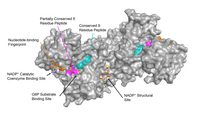
Photo from wikipedia
The relevant role of pentose phosphate pathway (PPP) in cancer metabolic reprogramming has been usually outlined by studying glucose-6-phosphate dehydrogenase (G6PD). However, recent evidence suggests an unexpected role for a… Click to show full abstract
The relevant role of pentose phosphate pathway (PPP) in cancer metabolic reprogramming has been usually outlined by studying glucose-6-phosphate dehydrogenase (G6PD). However, recent evidence suggests an unexpected role for a less characterized PPP, triggered by hexose-6-phosphate dehydrogenase (H6PD) within the endoplasmic reticulum (ER). Studying H6PD biological role in breast and lung cancer, here we show that gene silencing of this reticular enzyme decreases cell content of PPP intermediates and d-ribose, to a similar extent as G6PD silencing. Decrease in overall NADPH content and increase in cell oxidative status are also comparable. Finally, either gene silencing impairs at a similar degree cell proliferating activity. This unexpected response occurs despite the absence of any cross-interference between the expression of both G6PD and H6PD. Thus, overall cancer PPP reflects the contribution of two different pathways located in the cytosol and ER, respectively. Disregarding the reticular pathway might hamper our comprehension of PPP role in cancer cell biology.
Journal Title: Scientific Reports
Year Published: 2020
Link to full text (if available)
Share on Social Media: Sign Up to like & get
recommendations!